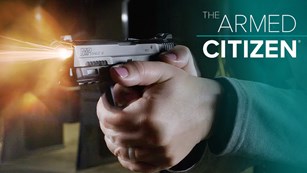
Women who carry a firearm do so for different reasons. For some, it’s a well-established habit; others are new and still need ideas on how to best implement the practice into their daily lives. Here are a few ways to make carrying a habit that happens easily.
IWB, OWB, Off-Body—All the Acronyms
How you carry depends on certain variables. Those variables might change from day to day and person to person. Are you doing errands? Do you have to go into buildings where you cannot bring your firearm? Are you on a long trip through several states with different laws? Are you heading out camping, boating or backpacking? Whatever your adventures are, you might want to carry a firearm. The method that you choose for carrying has a term. IWB means Inside Waistband. EDC means Every Day Carry. A list of these acronyms can be helpful, but the act of carrying doesn’t mean you have to turn yourself into a walking dictionary of terms. What you do need is a basic understanding of your options.
The Law
In order to figure out your options, start with knowing the laws governing how and where you carry. You need a basic understanding of what is required where you live. Depending on where you work or the places that you frequent, reading up on your local and state laws can be very important.
Choices
The way that you eventually choose to carry is often very personal. But it can be determined by outside forces—like the weather. If it’s very hot and you’re wearing a tank top and running tights, the OWB holster someone would wear under a light jacket is not going to work. Maybe you carry off-body in something like a fanny pack.
Personally, I don’t always have a bag in which I have my gun; most days, I wear it on my body. But when it’s hot, it can be easier to have an off-body carry. I often use a bag with a hook-and-loop system that holds the holster with my firearm in place.
Driving? Hiking? Kayaking? Maybe you just have to go to the grocery store … whatever it is, work toward developing simple habits and a plan that you can execute and will use versus acquiring the “perfect” set up. This means work on developing a method and gear that you can and will use instead of chasing after what a social media influencer suggests about the latest holster they are being paid to advertise. That’s because even though you might discover some perfect items, but you’re wasting time focusing on that instead of developing good skills. A spendy gadget is never better than time and money spent perfecting skill. I’d rather dry-fire and work on a draw from my current pants and IWB holster and perhaps work on a little live fire at the range than buy a trendy item.
Driving?
If you get into the habit of carrying in your vehicle, whether that’s in a bag, or in an appropriate receptacle in your vehicle (based on your state and local laws), it can be a sure way to always have some form of personal protection near at hand. If you are allowed by law to carry in a console or glove box, then ensure you still have a holster or some mechanism to secure the gun so it’s not moving or jostled while you travel.
It’s also a good idea to keep your firearm separate from where you keep your license and registration. Should you be pulled over by a police officer, you don’t want to open a glove box and have the officer see a firearm and make the wrong assumptions about what you are reaching for. A study of your local laws is a good place to begin building habits for carrying in your vehicle. Understand whether your firearm can be loaded or if it must be unloaded and locked in your trunk. Spare magazines should be kept in a secure place as well, safe from potentially becoming a receptacle for the inevitable piece of dash compartment debris.
Bags and Purses
If you carry a bag or a purse, think about something less cumbersome, so you aren’t apt to forget it and be without your firearm if needed. Lugging around a giant bag isn’t fun—between fanny packs and cross-body bags there are plenty of options. Practice your draw (using an empty gun of course!) with any bag that you use and make sure that your ability to access your firearm, draw and reload is not hampered by the configuration, or zippers, straps, etc.
Recreational Vehicles
Maybe your recreational vehicle is the baby jogger that you are pushing around the block, maybe it’s a side-by-side as you work on a farm, or maybe it’s a boat … whatever your recreational style, look for a couple things as you prepare to carry:
- Clear access to firearm
- No risk of flagging others, especially when drawing
- Failproof method of securing the firearm during movement so it cannot fall out of your rec vehicle. This could be a dash-mounted holster with locking mechanism, a gun rack or a bag you would use in your car.
- Clear understanding of laws governing transporting firearms in your rec vehicle (e.g., a side-by-side on a paved road might be subject to the same rules as a car, and a boat might have its own set of restrictions.)
On Your Body
The simplest and surest way to have your firearm handy is to wear it on your body. If you build your wardrobe thinking about just the basics (a shirt and pants), you will very likely tend toward inside the waistband (IWB) as a method of carrying. If you’re driving or in a recreational vehicle, on-body carry solves the concerns about where the firearm is secured. If you’re hiking, running, shopping … basically, anywhere you and your firearm can legally be—the way to ensure you have it is to have it on YOU.
Tips to make on-body carry work:
- Choose pants, shorts or a skirt with a waistband that will support a firearm and allow you to draw safely.
- Select shirts that allow you to access the firearm easily. If you want to conceal, this tends to mean a looser, non-restrictive shirt. However, keep in mind that anything with too much material can potentially end up in the way of your firearm as you re-holster or try to change mags.
- Find a lightweight holster that doesn’t add a lot of bulk to your firearm ... look for one with fabric that protects your firearm from sweat, but still stays put.
- Consider carry leggings or shorts that have a method for securing your firearm built-in. A corset might also be a great option, since some clothes have no pockets.
- Being comfortable and confident with your firearm and the use of it is the best accessory to carrying one.
In the end, carrying a firearm is like any other skill or tool. The more we practice and know the subject and use of the tool, the better prepared we are to use it.















































